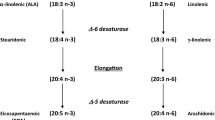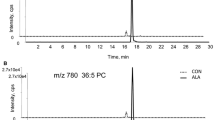Abstract
The objective of this study was to obtain functional information associated with the prevention by n−3 polyunsaturated fatty acids (PUFA) of ischemia-induced fatal cardiac ventricular arrhythmias in the intact, conscious, exercising dog. Thirteen dogs suceptible to ischemia-induced ventricular fibrillation were prepared surgically by ligation of their anterior descending left coronary artery and placement of an inflatable cuff around their left circumflex artery. After 4 wk of recovery, exercise-plus-ischemia tests were performed without and then with an intravenous infusion of an emulsion of free n−3 PUFA just prior to occluding the left circumflex artery while the animals were running on a treadmill. One week later the exercise-plus-ischemia test was repeated but with a control infusion replacing the emulsion of n−3 PUFA. The infusion of the free n−3 PUFA in quantities of 1.0 to 10 g prevented ventricular fibrillation in 10 of the 13 dogs tested (P<0.005), apparently without esterification of the PUFA into membrane phospholipids. The antiarrhythmic effect of the n−3 PUFA was associated with slowing of the heart rate, shortening of the QT-interval (electrical action potential duration), reduction of left ventricular systolic pressure, and prolongation of the electrocardiographic atrial-ventricular conduction time (P-R interval). These effects are comparable with those we have reported in studies with cultured neonatal rat cardiac myocytes.
Similar content being viewed by others
Abbreviations
- DHA:
-
cis-5,8, 11, 14, 17, 20-docosahexaenoic acid (22:6n−3)
- ECG:
-
electrocardiogram
- EPA:
-
cis-5,8,11,14,17-eicosapentaenoic acid (20:5n−3)
- NEFA:
-
nonesterified fatty acids [fraction of plasma lipids which includes the free fatty acids of which over 99.9% are bound to albumin and other plasma proteins plus a very small fraction of monometric free or aggregated clusters of fatty acids (lamellar or micellar aggregates) in plasma water]
- P-R interval:
-
duration of conduction time from the start of the auricular P-wave to start of the ventricular R-wave conventionally measured from the ECG
- PUFA:
-
polyunsaturated fatty acids (denotes the n−3 class of essential long-chain PUFA but more generally applied to both the n−3 and n−6 classes)
- QT interval:
-
an electrocardiographic interval from the start of the Q-wave to the start of the T-wave of the ECG (equivalent to the duration of the action potential observed in individual cardiac myocytes as an abrupt rise and fall in the transmembrane potential when their resting or diastolic membrane potential is depolarized and measured with an intracellular electrode and an external reference electrode; the electrical signal that initiates contractions of the heart muscle
- TLC:
-
thin-layer chromatography
- VF:
-
ventricular fibrillation, a fatal cardiac arrhythmia when sustained, characterized by grossly irregular, rapid, and chaotic beating
- VT:
-
ventricular flutter, a very rapid but regular beating rate which is also fatal is sustained
References
American Heart Association, Heart and Stroke Facts: Statistical Supplement (1995) Amercan Heart Association, Dallas.
Gudbjarnason, S., and Hallgrimsson, J. (1975) The Role of Myocardial Membrane Lipids in the Development of Cardiac Necrosis. Acta Med. Scand. suppl. 587, 17–26.
Murnaghan, M.F. (1975) Effects of Fatty Acids on the Ventricular Arrhythmia Threshold in the Isolated Heart of Rabbits, Br. J. Pharmacol., 73, 909–915.
McLennan, P.L. (1993) Relative Dietary Effects of Dietary Saturated. Monounsaturated, and Polyunsaturated Fatty Acids on Cardiac Arrhythmias in Rats. Am. J. Clin. Nutr. 57, 207–212.
McLennan, P.L., Abeywardena, M.Y., and Charnock J.S. (1985) Influence of Dietary Lipid on Arrhythmias and Infarction After Coronary Artery Ligation in Rats, Can. J. Physiol. Pharmacol. 63, 1411–1417.
McLennan, P.L., Bridle, T.M., Abeywardena, M.Y., and Charnock, J.S. (1992) Dietary Lipid Modulation of Ventricular Fibrillation Threshold in the Marmoset, Am. Heart J. 123, 1555–1561.
Billman, G.E., Hallaq, H., and Leaf, A. (1994) Prevention of Ischemia-Induced Ventricular Fibrillation by ω3 Fatty Acids. Proc. Natl. Acad. Sci. USA, 91, 4427–4430.
Billman, G.E. (1989) Effect of Calcium Channel Antagonists on Susceptibility to Sudden Death: Protection from Ventricular Fibrillation, J. Pharmacol. Exp. Therap. 248, 1334–1342.
Billman, G.E., Schwartz, P.J., and Stone, H.L. (1989) Baroreceptor Reflex Control of Heart Rate: A Predictor of Sudden Cardiac Death, Circulation, 66, 874–880.
Schwartz, P.J., Billman, G.E., and Stone, H. (1984) Autonomic Mechanisms in Ventricular Fibrillation Induced by Myocardial Ischemia During Exercise in Dogs with Healed Myocardial Infarction: an Experimental Preparation for Sudden Cardiac Death. Circulation 69, 790–800.
Weylandt, K.H., Kang, J.X., and Leaf, A. (1996) Polyunsaturated Fatty Acids Exert Antiarrhythmic Actions as Free Fatty Acids Rather Than in Phospholipids, Lipids 31, 977–982.
Bazett, H.C. (1920) An Analysis of Time Relations of the Electrocardiogram. Heart 7, 353–370.
Kang, J.X., and Leaf, A. (1994) Effects of Long-Chain Polyunsaturated Fatty Acids on the Contraction of Neonatal Rat Cardiac Myocytes, Proc. Natl. Acad. Sci. USA, 91, 9886–9890.
Billman, G.E., and Leaf, A. (1996) Purified ω3 Fatty Acids Prevent Ventricular Fibrillation Induced by Myocardial Ischemia, Circulation, 94, I-307 (Abstract).
Kamp, F., and Hamilton, J.A. (1992) pH Gradients Across Phospholipid Membranes Caused by Fast Flip-Flop of Un-ionized Fatty Acids, Proc. Natl. Acad. Sci. USA 89, 11367–11370.
Noy, N., Donnelly, T.M., and Zakim, D. (1986) Physical Chemical Model for the Entry of Water-Insoluble Compounds into Cells. Studies of Fatty Acid Uptake by the Liver. Biochemistry, 25, 2013–2021.
Xiao, Y-F., Gomez, A.M., Morgan, J.P., Lederer, W.J., and Leaf, A. (1997) Suppression of Voltage-gated L Type Ca2+ Currents by Polyunsaturated Fatty Acids in Adult and Neonatal Rat Ventricular Myocytes, Proc. Natl. Acad Sci. USA, 94, in press.
Richieri, G.V., and Kleinfeld, A.M. (1995) Unbound (Free) Fatty Acids in Human Serum, J. Lipid Res. 36, 229–240.
Rose, H., Convetz, M., Fischer, Y., Jungling, E., Hennecke, T., and Kammermeir, H. (1994) Long-Chain Fatty Acid-Binding to Albumin: Reevaluation with Directly Measured Concentrations. Biochim. Biophys. Acta 1215, 321–326.
Kinoshita, I., Utoh, K., Nishiuda-Nakai, M., Hirota, H., Otsuji, S., and Shibato, N., (1994) Antiarrhythmic Effects of Eicosapentaenoic Acid During Myocardial Infarction, Jap. Circ. J. 58, 903–912.
Kang, J.X., and Leaf, A. (1995) Prevention and Termination of the β-Adrenergic Agonist-Induced Arrhythmias by Free Polyunsaturated Fatty Acids in Neonatal Rat Cardiac Myocytes, Biochem. Biophys. Res., Commun. 208, 629–636.
Kang, J.X., Xiao, Y-F., and Leaf, A. (1995) Free, Long-Chain Polyunsaturated Fatty Acids Reduce Membrane Electrical Excitability in Neonatal Rat Cardiac Myocytes. Proc. Natl. Acad. Sci. USA 92, 3997–4001.
Xiao, Y.F., Kang, J.X., Morgan, J., and Leaf, A. (1995) Blocking Effects of Polyunsaturated Fatty Acids on Na+ Channels of Neonatal Rat Ventricular Myocytes. Proc. Natl. Acad. Sci. USA 92, 11000–11004.
Knapp, H.R., and FitzGerald, G.A. (1989) The Antihypertensive Effects of Fish Oil: A Controlled Study of Polyunsaturated Fatty Acids Supplements in Essential Hypertension, N. Engl. J. Med., 320, 1037–1043.
Shimokawa, H., and Vanhoutte, P.M. (1988) Dietary n−3 Fatty Acids and Endothelium-Dependent Relaxations in Porcine Coronary Arteries. Am. J. Physiol. 254, H968-H973.
Malis, C.D., Leaf, A., Varadarajan, G.S., Newell, J.B., Weber, P.C., Force, T., and Bonventre, J.V. (1991) Effect of Dietary Omega-3 Fatty Acids on Vascular Contractility and Post-Anoxic Aortic Rings. Circulation, 84, 1393–1401.
Hock, C.E., Beck, L.D., Bodon, R.C., and Reibel, D.K. (1990) Influence of Dietary n−3 Fatty Acids on Myocardial Ischemia and Reperfusion, Am. J. Physiol., 259, H1518-H1526.
Burr, L.M., Gilbert, F.J., Holliday, M.R., Elwood, P.C., Fehily, M.A., Rogers, S., Sweetnam, M.P., and Deadman, M.N. (1989) Effects of Changes in Fat, Fish, and Fibre Intakes on Death and Myocardial Reinfarction (DART), Lancet 334, 757–776.
de Logeril, M., Renaud, S., Mamelle, N., Salen, P., Martin, J.L., Monjaud, I., Guidollet, J., Touboul, P., and Delaye, J. (1994) Mediterranean Alpha-Linolenic Acid-Rich Diet in Secondary Prevention of Coronary Heart Disease, Lancet 343, 1454–1459.
Kang, J.X., and Leaf, A. (1996) Evidence That Free Polyunsaturated Fatty Acids Modify Na+ Channels by Directly Binding to the channel Proteins, Proc. Natl. Acad. Sci. USA, 94, 2724–2728.
Vaughan Williams, E.M. (1984) A Classification of Antiarrhythmic Actions Reassessed After a Decade of New Drugs, Clin. Pharmacol., 24, 129–147.
Kirber, M.T., Ordway, R.W., Clapp, L.H., Walsh, J.V. Jr., and Singer, J.J. (1992) Both Membrane Stretch and Fatty Acids Directly Activate Large Conductance Ca2+-activated K+ Channels in Vascular Smooth Muscle Cells, Fed. Exp. Biol. Soc., 297, 24–28.
Ordway, R.W., Walsh, J.V., Jr., and Singer, J.J. (1989) Arachidonic Acid and Other Fatty Acids Directly Activate Potassium Channels in Smooth Muscle Cells, Science 244, 1176–1179.
Poling, J.S., Karanian, J.W., Salem, N., Jr., and Vicini, S. (1995) Time- and Voltage-Dependent Block of Delayed Rectifier Potassium Channels by Docosahexaenoic Acid, Mol. Pharmacol. 47, 381–390.
Schmitt, H., and Meves, H. (1995) Modulation of Neuronal Calcium Channels by Arachidonic Acid and Related Substances, J. Membrane Biol., 145, 233–244.
Shimada, T., and Somlyo, A.P. (1992) Modulation of Voltage-Dependent Ca2+ Channel Current by Arachidonic Acid and Other Long-Chain Fatty Acids in Rabbit Intestinal Smooth Muscle, J. Gen. Physiol., 100, 27–44.
Vreugdenhil, M., Bruehl, C., Voskuyl, R., Kang, J.X., Leaf, A., and Wadman, W.J. (1996) Polyunsaturated Fatty Acids Modulate Sodium and Calcium Currents in CA1 Neurons. Proc. Nat. Acad. Sci. USA 93, 12559–12563.
Author information
Authors and Affiliations
Corresponding author
About this article
Cite this article
Billman, G.E., Kang, J.X. & Leaf, A. Prevention of ischemia-induced cardiac Sudden death by n−3 polyunsaturated fatty acids in dogs. Lipids 32, 1161–1168 (1997). https://doi.org/10.1007/s11745-997-0149-2
Received:
Revised:
Accepted:
Issue Date:
DOI: https://doi.org/10.1007/s11745-997-0149-2




